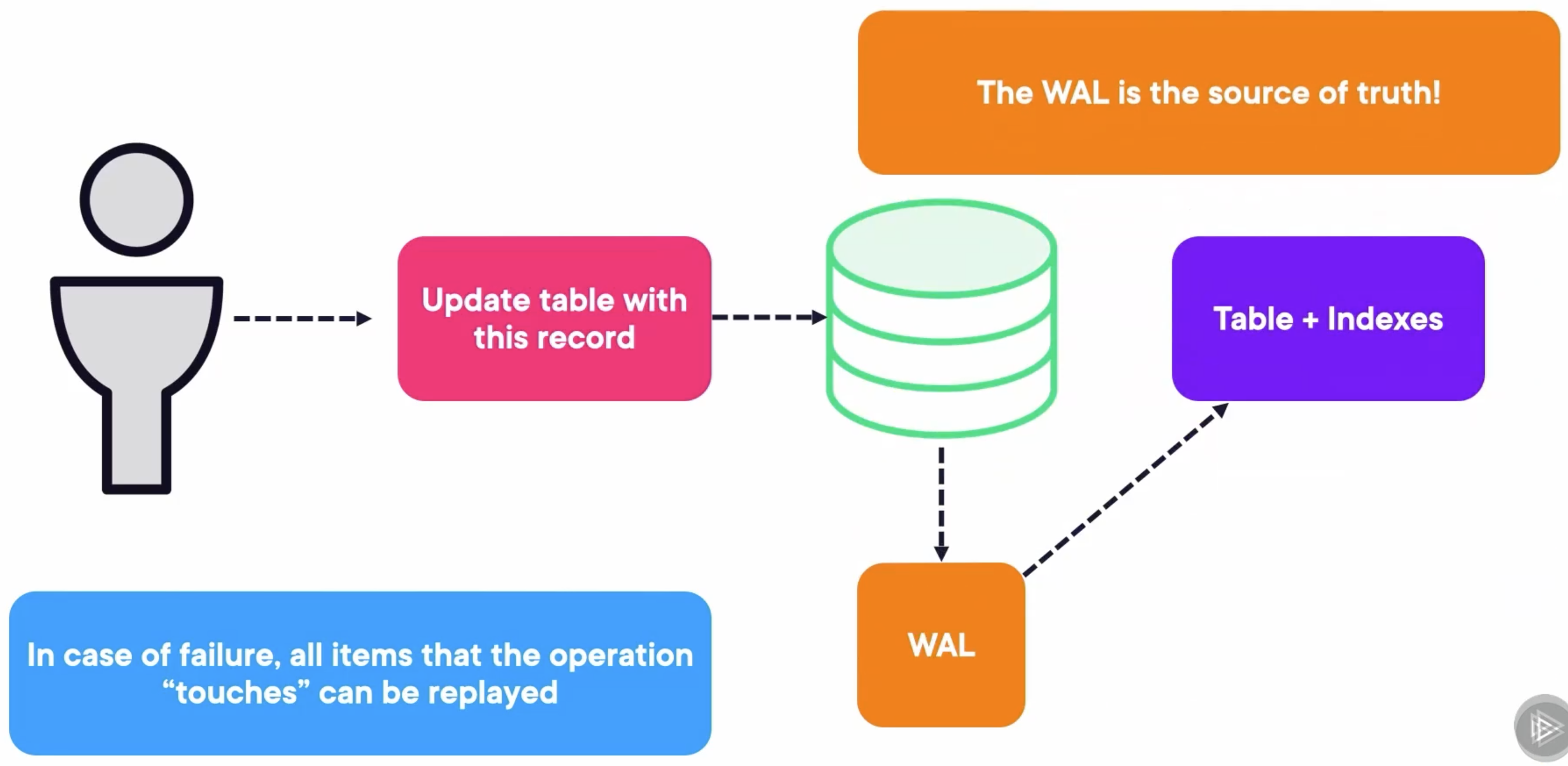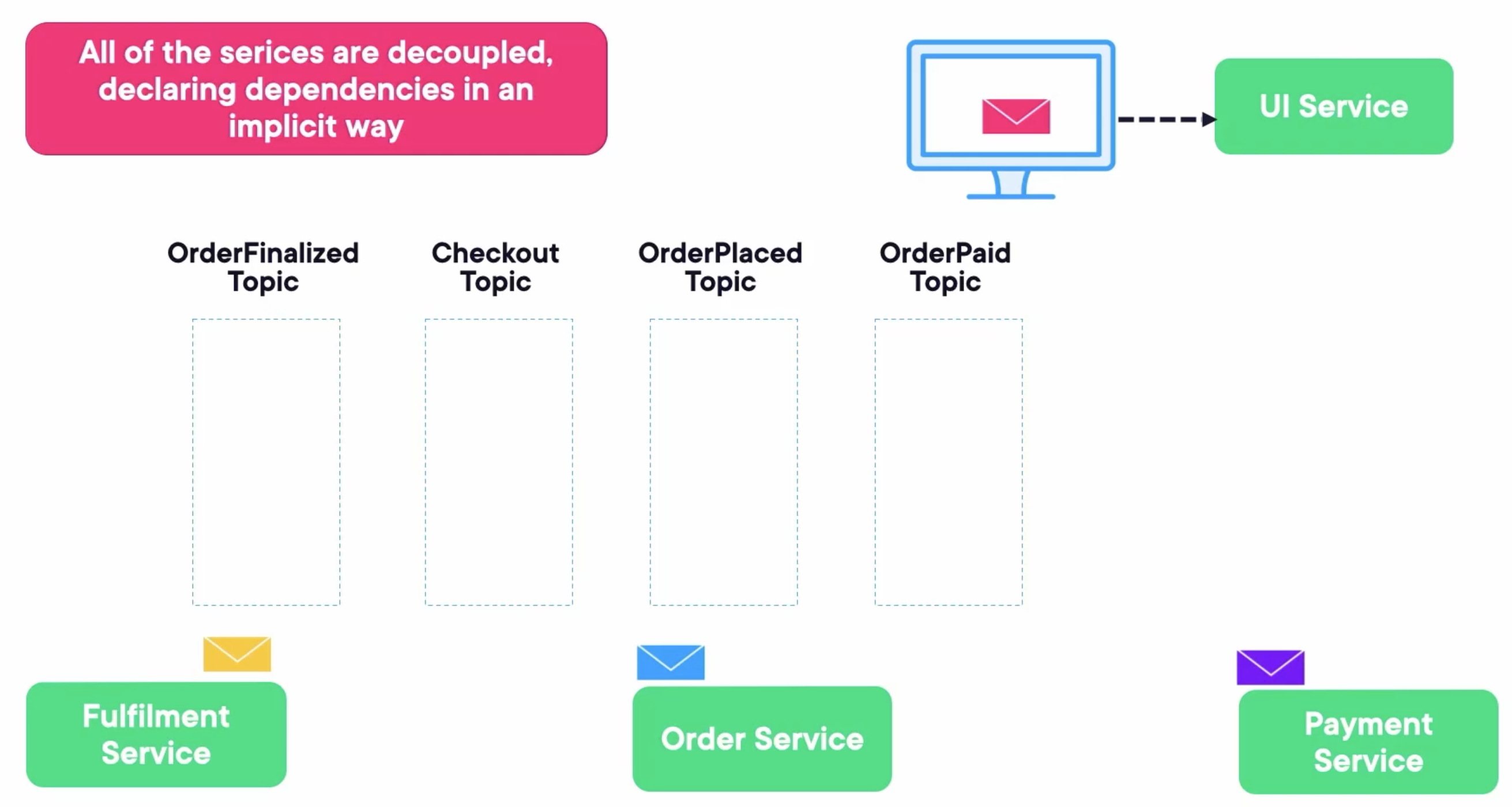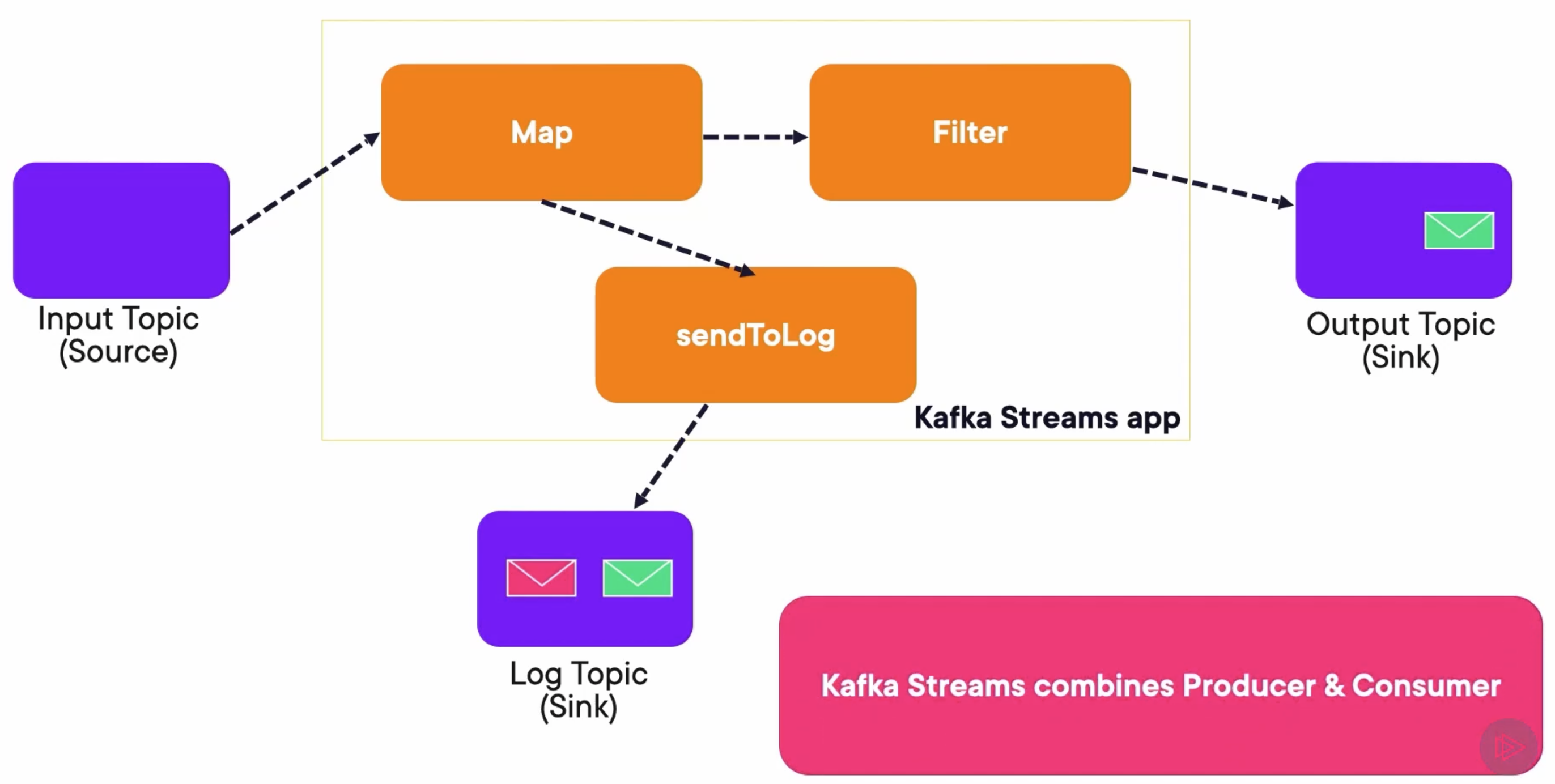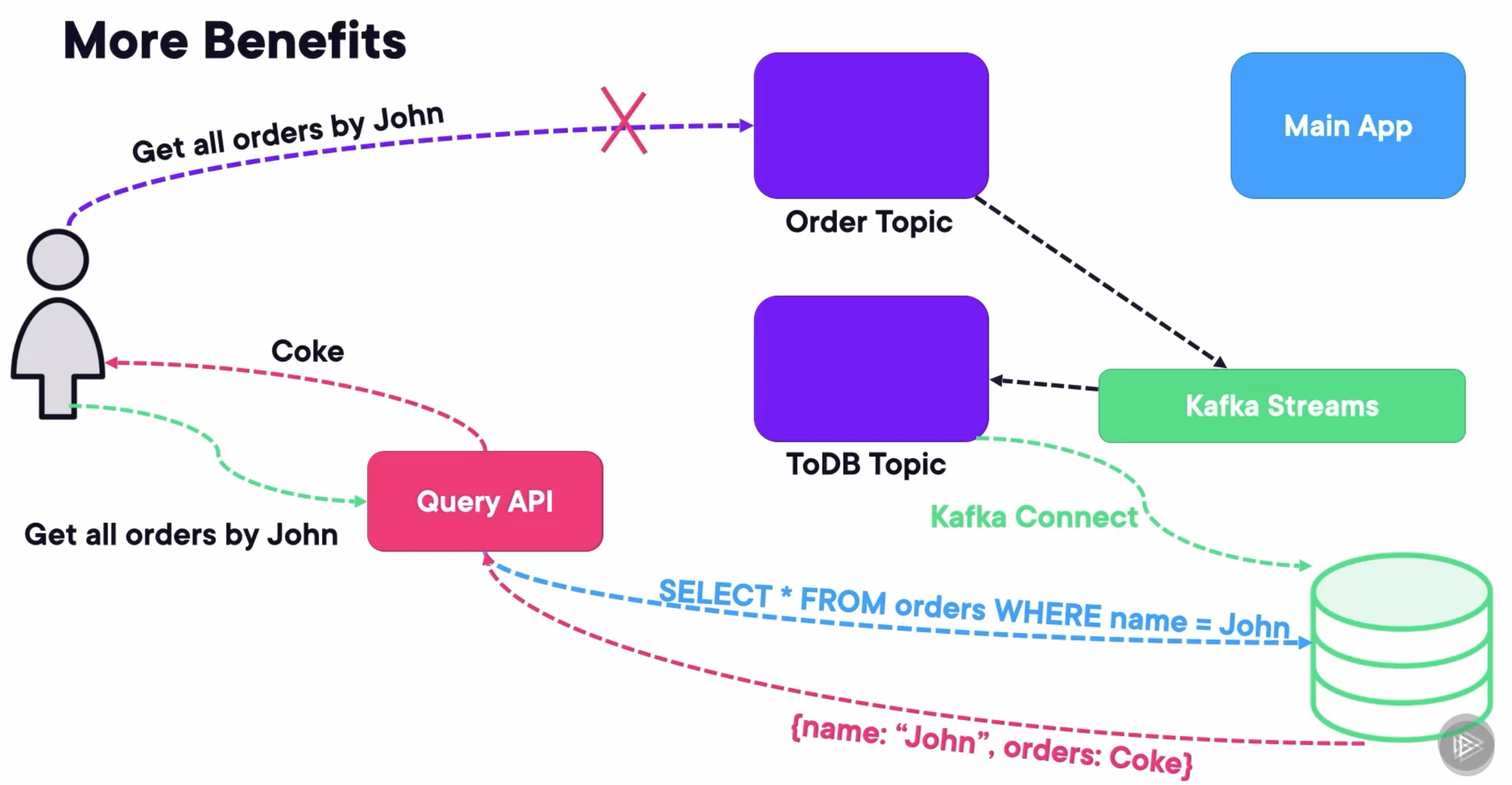Microservices with Kafka
To understand the logic behind doing microservices with Kafka, I believe it is important to take a smaller tour of how databases work. The engine uses a file called the write‑ahead log, or WAL. First, it writes the operation to the WAL. Then, it executes operations on the tables and indexes to reflect what the WAL said they should look like.

We have normally two types of microservices:
- The first one is the synchronous microservices. These are the normal ones, normally RESTful services that wait on other dependent services to respond.
- The asynchronous microservices have an event bus based on these futures or callbacks. Here is where we tie the knot because if we let Kafka become the center of the application, we can build an entire async application based on it. And to make it simpler, this is what Kafka Streams chimes in to create each of these services.

Let’s see an example that an e-commerce application may clarify.
- UI Service -> send message -> Checkout Topic -> receive message -> Order Service
- Order Service -> send message -> OrderPlaced Topic -> receive message -> Payment Service
- Payment Service -> send message -> OrderPaid Topic -> receive message -> Fulfilment Service
- Fulfillment Service -> send message -> OrderFinalized Topic -> receive message -> UI Service

Kafka will be the center. There are some reasons:
- Every event happening in your application can be traced back to a Kafka topic, and that is stored.
- This also means that if each of these microservices is a Kafka Stream app, everything in your app goes through Kafka. Kafka topics have an abstraction called the log that allows messages to be replayed.
- This means Kafka becomes the WAL of the application and allows for things like multi-phase transactions.
Kafka Streams and Stateless Stream Processing
This is what Kafka Stream apps look like. They read from an input topic, which is the source. They perform some operations defined in a graph or topology. Finally, they write normally to an output topic. Optionally, they can write to another topic that can act as a log.
The map operation maps this green message to sendToLog, as well as to the Filter. As this one is green, it passes the Filter. Then the app produces the message to both the Output Topic, as well as the Log Topic.
On the other hand, the red message is mapped to the Filter and sendToLog, but it cannot pass the filter. So, it’s only sent to the Log Topic.

There are more benefits. Thanks to Kafka Connect and Kafka Streams, querying Kafka will be easier. If we set up a Kafka Streams app that takes the orders topic and writes it to a DB topic in the correct schema defined by the schema registry with Avro, then Kafka Connect can use the database connector to write it to a database like PostgreSQL or MongoDB. From there, we can expose a query API that only translates certain RESTful requests into DB queries.

Creating a Kafka Streams Application
Establishing Properties
- Create an application.id that represents your application group or “team”
- Serde is combination of Serializer/Deserializer
- Every stream application and KSQL app (later) is a consumer-producer
Properties props = new Properties();
props.put(StreamsConfig.APPLICATION_ID_CONFIG, "my_stream_app");
props.put(StreamsConfig.BOOTSTRAP_SERVERS_CONFIG, "localhost:9092");
props.put(StreamsConfig.DEFAULT_KEY_SERDE_CLASS_CONFIG, Serdes.String().getClass());
props.put(StreamsConfig.DEFAULT_VALUE_SERDE_CLASS_CONFIG, Serdes.String().getClass());
props.put("schema.registry.url", "http://localhost:8081");
Create a Stream Builder
- Always start with a StreamBuilder object.
- This is the GoF builder pattern, where we will create a Topology object that represents our data pipeline.
StreamsBuilder builder = new StreamsBuilder();
KStream<String, DisasterValue> rawReadings = builder.stream("DisasterReadings", Consumed.with(Serdes.String(), Serdes.Integer()));
Standard Functional Programming
map, filter, flatMap, groupBy, reduce, window, join, leftJoin, outerJoin
Mapping
Before: (1, “Hello”), (2, “Zoom”), (3, “Fold”)
stream.map((key, value) -> new KeyValue<>(key + 1, value + "!"));
After: (2, “Hello!”), (3, “Zoom!”), (4, “Fold!”)
Filter
Before: (1, “Hello”), (2, “Zoom”), (3, “Fold”), (4, “Past”)
stream.filter((key, value) -> key % 2 == 0);
(2, “Zoom”), (4, “Past”)
Dump Results to a Topic
Dump the results to a topic using through to post to the topic and continue.
KStream stream = builder.stream("my_topic");
stream.filter(...).through("new_topic").flatMap(...).to("other_topic");
Run
Topology topology = builder.build();
KafkaStreams streams = new KafkaStreams(topology, props);
streams.start();
Adding a Shutdown Hook
Runtime.getRuntime().addShutdownHook(new Thread(streams::close));
Demo: Creating a Kafka Streams Application
Run Docker Containers
Create a docker-compose file, including three zookeepers, three Kafka brokers, a Rest Proxy, and a Schema Registry.
---
version: '3'
services:
zookeeper-1:
image: confluentinc/cp-zookeeper:7.4.1
hostname: zookeeper-1
container_name: zookeeper-1
volumes:
- ./zookeeper-1_data:/var/lib/zookeeper/data
- ./zookeeper-1_log:/var/lib/zookeeper/log
environment:
ZOOKEEPER_CLIENT_PORT: 2181
ZOOKEEPER_TICK_TIME: 2000
ZOO_MY_ID: 1
ZOO_SERVERS: server.1=zookeeper-1:2888:3888;2181 server.2=zookeeper-2:2888:3888;2181 server.3=zookeeper-3:2888:3888;2181
zookeeper-2:
image: confluentinc/cp-zookeeper:7.4.1
hostname: zookeeper-2
container_name: zookeeper-2
volumes:
- ./zookeeper-2_data:/var/lib/zookeeper/data
- ./zookeeper-2_log:/var/lib/zookeeper/log
environment:
ZOOKEEPER_CLIENT_PORT: 2181
ZOOKEEPER_TICK_TIME: 2000
ZOO_MY_ID: 2
ZOO_SERVERS: server.1=zookeeper-1:2888:3888;2181 server.2=zookeeper-2:2888:3888;2181 server.3=zookeeper-3:2888:3888;2181
zookeeper-3:
image: confluentinc/cp-zookeeper:7.4.1
hostname: zookeeper-3
container_name: zookeeper-3
volumes:
- ./zookeeper-3_data:/var/lib/zookeeper/data
- ./zookeeper-3_log:/var/lib/zookeeper/log
environment:
ZOOKEEPER_CLIENT_PORT: 2181
ZOOKEEPER_TICK_TIME: 2000
ZOO_MY_ID: 3
ZOO_SERVERS: server.1=zookeeper-1:2888:3888;2181 server.2=zookeeper-2:2888:3888;2181 server.3=zookeeper-3:2888:3888;2181
broker-1:
image: confluentinc/cp-kafka:7.4.1
hostname: broker-1
container_name: broker-1
volumes:
- ./broker-1-data:/var/lib/kafka/data
depends_on:
- zookeeper-1
- zookeeper-2
- zookeeper-3
ports:
- 9092:9092
- 29092:29092
environment:
KAFKA_BROKER_ID: 1
KAFKA_ZOOKEEPER_CONNECT: zookeeper-1:2181
KAFKA_ADVERTISED_LISTENERS: HOST://localhost:9092,INTERNAL://broker-1:29092
KAFKA_LISTENER_SECURITY_PROTOCOL_MAP: HOST:PLAINTEXT,INTERNAL:PLAINTEXT
KAFKA_INTER_BROKER_LISTENER_NAME: INTERNAL
KAFKA_SNAPSHOT_TRUST_EMPTY: true
broker-2:
image: confluentinc/cp-kafka:7.4.1
hostname: broker-2
container_name: broker-2
volumes:
- ./broker-2-data:/var/lib/kafka/data
depends_on:
- zookeeper-1
- zookeeper-2
- zookeeper-3
- broker-1
ports:
- 9093:9093
- 29093:29093
environment:
KAFKA_BROKER_ID: 2
KAFKA_ZOOKEEPER_CONNECT: zookeeper-1:2181
KAFKA_ADVERTISED_LISTENERS: HOST://localhost:9093,INTERNAL://broker-2:29093
KAFKA_LISTENER_SECURITY_PROTOCOL_MAP: HOST:PLAINTEXT,INTERNAL:PLAINTEXT
KAFKA_INTER_BROKER_LISTENER_NAME: INTERNAL
KAFKA_SNAPSHOT_TRUST_EMPTY: true
broker-3:
image: confluentinc/cp-kafka:7.4.1
hostname: broker-3
container_name: broker-3
volumes:
- ./broker-3-data:/var/lib/kafka/data
depends_on:
- zookeeper-1
- zookeeper-2
- zookeeper-3
- broker-1
- broker-2
ports:
- 9094:9094
- 29094:29094
environment:
KAFKA_BROKER_ID: 3
KAFKA_ZOOKEEPER_CONNECT: zookeeper-1:2181
KAFKA_ADVERTISED_LISTENERS: HOST://localhost:9094,INTERNAL://broker-3:29094
KAFKA_LISTENER_SECURITY_PROTOCOL_MAP: HOST:PLAINTEXT,INTERNAL:PLAINTEXT
KAFKA_INTER_BROKER_LISTENER_NAME: INTERNAL
KAFKA_SNAPSHOT_TRUST_EMPTY: true
rest-proxy:
image: confluentinc/cp-kafka-rest:7.4.1
ports:
- "8082:8082"
depends_on:
- zookeeper-1
- zookeeper-2
- zookeeper-3
- broker-1
- broker-2
- broker-3
hostname: rest-proxy
container_name: rest-proxy
environment:
KAFKA_REST_HOST_NAME: rest-proxy
KAFKA_REST_BOOTSTRAP_SERVERS: 'broker-1:29092,broker-2:29093,broker-3:29094'
KAFKA_REST_LISTENERS: "http://0.0.0.0:8082"
schema-registry:
image: confluentinc/cp-schema-registry:7.4.1
hostname: schema-registry
container_name: schema-registry
depends_on:
- rest-proxy
ports:
- "8081:8081"
environment:
SCHEMA_REGISTRY_HOST_NAME: schema-registry
SCHEMA_REGISTRY_KAFKASTORE_BOOTSTRAP_SERVERS: 'broker-1:29092,broker-2:29093,broker-3:29094'
Run composed containers:
docker compose up -d
Create two Topics
Create a RawTeampReadings topic that has 4 partitions.
kafka-topics.sh --create --bootstrap-server localhost:9092 --partitions 4 --topic RawTempReadings
Then create a ValidatedTempReadings topic that has 4 partitions.
kafka-topics.sh --create --bootstrap-server localhost:9092 --partitions 4 --topic ValidatedTempReadings
Create a Consumer
kafka-console-consumer.sh \
--bootstrap-server localhost:9092 \
--topic ValidatedTempReadings --from-beginning \
--key-deserializer org.apache.kafka.common.serialization.StringDeserializer \
--value-deserializer org.apache.kafka.common.serialization.IntegerDeserializer \
--property print.key=true \
--property key.separator=, \
--group 1
Run a Stream
Run a Kafka Stream from topic RawTempReadings to topic ValidatedTempReadings, only filtering the messages whose values are between -50 and 130.
package com.globomantics;
import org.apache.kafka.common.serialization.Serdes;
import org.apache.kafka.streams.KafkaStreams;
import org.apache.kafka.streams.StreamsBuilder;
import org.apache.kafka.streams.StreamsConfig;
import org.apache.kafka.streams.Topology;
import org.apache.kafka.streams.kstream.KStream;
import java.util.Properties;
public class SimpleETL {
public static void main(String[] args) {
Properties props = new Properties();
props.put(StreamsConfig.APPLICATION_ID_CONFIG, "weather.filter");
props.put(StreamsConfig.BOOTSTRAP_SERVERS_CONFIG, "http://localhost:9092,http://localhost:9093,http://localhost:9094");
props.put(StreamsConfig.DEFAULT_KEY_SERDE_CLASS_CONFIG,
Serdes.String().getClass());
props.put(StreamsConfig.DEFAULT_VALUE_SERDE_CLASS_CONFIG,
Serdes.Integer().getClass());
StreamsBuilder builder = new StreamsBuilder();
KStream<String, Integer> rawReadings = builder.stream("RawTempReadings");
KStream<String, Integer> validatedReadings = rawReadings
.filter((key, value) -> value > -50 && value < 130);
validatedReadings.to("ValidatedTempReadings");
Topology topo = builder.build();
System.out.println(topo.describe());
KafkaStreams streams = new KafkaStreams(topo, props);
Runtime.getRuntime().addShutdownHook(new Thread(streams::close));
streams.cleanUp();
streams.start();
System.out.println("Starting simple ETL");
}
}
Run a Producer
Run a Kafka Producer that sends messages to the topic RawTempReadings, which sends messages whose values are between -20 and 180.
package com.globomantics;
import org.apache.kafka.clients.producer.KafkaProducer;
import org.apache.kafka.clients.producer.ProducerConfig;
import org.apache.kafka.clients.producer.ProducerRecord;
import org.apache.kafka.common.serialization.IntegerSerializer;
import org.apache.kafka.common.serialization.StringSerializer;
import org.slf4j.Logger;
import org.slf4j.LoggerFactory;
import java.util.Properties;
import java.util.Random;
import java.util.concurrent.ThreadLocalRandom;
public class Producer {
private static final Logger log = LoggerFactory.getLogger(Producer.class);
private static final Properties props = new Properties();
public static void main(String[] args) throws InterruptedException {
props.put(ProducerConfig.BOOTSTRAP_SERVERS_CONFIG, "http://localhost:9092,http://localhost:9093,http://localhost:9094");
props.put(ProducerConfig.KEY_SERIALIZER_CLASS_CONFIG, StringSerializer.class.getName());
props.put(ProducerConfig.VALUE_SERIALIZER_CLASS_CONFIG, IntegerSerializer.class.getName());
KafkaProducer<String, Integer> producer = new KafkaProducer<>(props);
String[] sensors = new String[]{"sensor_1", "sensor_2", "sensor_3"};
Runtime.getRuntime().addShutdownHook(new Thread(producer::close));
while (true) {
int idx = new Random().nextInt(sensors.length);
String key = (sensors[idx]);
int value = ThreadLocalRandom.current().nextInt(-20, 180 + 1);
ProducerRecord<String, Integer> producerRecord =
new ProducerRecord<>("RawTempReadings", key, value);
producer.send(producerRecord);
producer.flush();
log.info("Successfully produced message from sensor " + key);
Thread.sleep(200);
}
}
}
We can see the received messages from the consumer, whose values are only between -50 and 130, which have been filtered by the Kafka Stream successfully.
❯ kafka-console-consumer.sh \
--bootstrap-server localhost:9092 \
--topic ValidatedTempReadings --from-beginning \
--key-deserializer org.apache.kafka.common.serialization.StringDeserializer \
--value-deserializer org.apache.kafka.common.serialization.IntegerDeserializer \
--property print.key=true \
--property key.separator=, \
--group 1
sensor_2,89
sensor_2,86
sensor_1,75
sensor_1,0
sensor_2,39
sensor_3,-11
sensor_3,106
sensor_1,84
sensor_1,52
sensor_1,122
sensor_1,53
sensor_2,117
sensor_3,-10
sensor_1,16
sensor_2,113
sensor_3,-11
Querying a Stream with KSQL
Run Docker Containers
Create a docker-compose file, including three zookeepers, three Kafka brokers, a Rest Proxy, a Schema Registry, a KSQL DB Server, and a KSQL DB Client.
---
version: '3'
services:
zookeeper-1:
image: confluentinc/cp-zookeeper:7.4.1
hostname: zookeeper-1
container_name: zookeeper-1
volumes:
- ./zookeeper-1_data:/var/lib/zookeeper/data
- ./zookeeper-1_log:/var/lib/zookeeper/log
environment:
ZOOKEEPER_CLIENT_PORT: 2181
ZOOKEEPER_TICK_TIME: 2000
ZOO_MY_ID: 1
ZOO_SERVERS: server.1=zookeeper-1:2888:3888;2181 server.2=zookeeper-2:2888:3888;2181 server.3=zookeeper-3:2888:3888;2181
zookeeper-2:
image: confluentinc/cp-zookeeper:7.4.1
hostname: zookeeper-2
container_name: zookeeper-2
volumes:
- ./zookeeper-2_data:/var/lib/zookeeper/data
- ./zookeeper-2_log:/var/lib/zookeeper/log
environment:
ZOOKEEPER_CLIENT_PORT: 2181
ZOOKEEPER_TICK_TIME: 2000
ZOO_MY_ID: 2
ZOO_SERVERS: server.1=zookeeper-1:2888:3888;2181 server.2=zookeeper-2:2888:3888;2181 server.3=zookeeper-3:2888:3888;2181
zookeeper-3:
image: confluentinc/cp-zookeeper:7.4.1
hostname: zookeeper-3
container_name: zookeeper-3
volumes:
- ./zookeeper-3_data:/var/lib/zookeeper/data
- ./zookeeper-3_log:/var/lib/zookeeper/log
environment:
ZOOKEEPER_CLIENT_PORT: 2181
ZOOKEEPER_TICK_TIME: 2000
ZOO_MY_ID: 3
ZOO_SERVERS: server.1=zookeeper-1:2888:3888;2181 server.2=zookeeper-2:2888:3888;2181 server.3=zookeeper-3:2888:3888;2181
broker-1:
image: confluentinc/cp-kafka:7.4.1
hostname: broker-1
container_name: broker-1
volumes:
- ./broker-1-data:/var/lib/kafka/data
depends_on:
- zookeeper-1
- zookeeper-2
- zookeeper-3
ports:
- 9092:9092
- 29092:29092
environment:
KAFKA_BROKER_ID: 1
KAFKA_ZOOKEEPER_CONNECT: zookeeper-1:2181
KAFKA_ADVERTISED_LISTENERS: HOST://localhost:9092,INTERNAL://broker-1:29092
KAFKA_LISTENER_SECURITY_PROTOCOL_MAP: HOST:PLAINTEXT,INTERNAL:PLAINTEXT
KAFKA_INTER_BROKER_LISTENER_NAME: INTERNAL
KAFKA_SNAPSHOT_TRUST_EMPTY: true
broker-2:
image: confluentinc/cp-kafka:7.4.1
hostname: broker-2
container_name: broker-2
volumes:
- ./broker-2-data:/var/lib/kafka/data
depends_on:
- zookeeper-1
- zookeeper-2
- zookeeper-3
- broker-1
ports:
- 9093:9093
- 29093:29093
environment:
KAFKA_BROKER_ID: 2
KAFKA_ZOOKEEPER_CONNECT: zookeeper-1:2181
KAFKA_ADVERTISED_LISTENERS: HOST://localhost:9093,INTERNAL://broker-2:29093
KAFKA_LISTENER_SECURITY_PROTOCOL_MAP: HOST:PLAINTEXT,INTERNAL:PLAINTEXT
KAFKA_INTER_BROKER_LISTENER_NAME: INTERNAL
KAFKA_SNAPSHOT_TRUST_EMPTY: true
broker-3:
image: confluentinc/cp-kafka:7.4.1
hostname: broker-3
container_name: broker-3
volumes:
- ./broker-3-data:/var/lib/kafka/data
depends_on:
- zookeeper-1
- zookeeper-2
- zookeeper-3
- broker-1
- broker-2
ports:
- 9094:9094
- 29094:29094
environment:
KAFKA_BROKER_ID: 3
KAFKA_ZOOKEEPER_CONNECT: zookeeper-1:2181
KAFKA_ADVERTISED_LISTENERS: HOST://localhost:9094,INTERNAL://broker-3:29094
KAFKA_LISTENER_SECURITY_PROTOCOL_MAP: HOST:PLAINTEXT,INTERNAL:PLAINTEXT
KAFKA_INTER_BROKER_LISTENER_NAME: INTERNAL
KAFKA_SNAPSHOT_TRUST_EMPTY: true
rest-proxy:
image: confluentinc/cp-kafka-rest:7.4.1
ports:
- "8082:8082"
depends_on:
- zookeeper-1
- zookeeper-2
- zookeeper-3
- broker-1
- broker-2
- broker-3
hostname: rest-proxy
container_name: rest-proxy
environment:
KAFKA_REST_HOST_NAME: rest-proxy
KAFKA_REST_BOOTSTRAP_SERVERS: 'broker-1:29092,broker-2:29093,broker-3:29094'
KAFKA_REST_LISTENERS: "http://0.0.0.0:8082"
schema-registry:
image: confluentinc/cp-schema-registry:7.4.1
hostname: schema-registry
container_name: schema-registry
depends_on:
- rest-proxy
ports:
- "8081:8081"
environment:
SCHEMA_REGISTRY_HOST_NAME: schema-registry
SCHEMA_REGISTRY_KAFKASTORE_BOOTSTRAP_SERVERS: 'broker-1:29092,broker-2:29093,broker-3:29094'
ksqldb-server:
image: confluentinc/cp-ksqldb-server:7.4.1
hostname: ksqldb-server
container_name: ksqldb-server
depends_on:
- schema-registry
ports:
- "8088:8088"
environment:
KSQL_LISTENERS: http://0.0.0.0:8088
KSQL_BOOTSTRAP_SERVERS: broker-1:29092,broker-2:29093,broker-3:29094
KSQL_KSQL_LOGGING_PROCESSING_STREAM_AUTO_CREATE: "true"
KSQL_KSQL_LOGGING_PROCESSING_TOPIC_AUTO_CREATE: "true"
ksqldb-cli:
image: confluentinc/cp-ksqldb-cli:7.4.1
container_name: ksqldb-cli
hostname: ksqldb-cli
depends_on:
- ksqldb-server
entrypoint: /bin/sh
tty: true
Run composed containers:
docker compose up -d
Run KSQL CLient
docker exec -it ksqldb-cli ksql http://ksqldb-server:8088
We can show all the topics:
ksql> show all topics;
Kafka Topic | Partitions | Partition Replicas
--------------------------------------------------------------------------
_confluent-ksql-default__command_topic | 1 | 1
_schemas | 1 | 3
default_ksql_processing_log | 1 | 1
--------------------------------------------------------------------------
Then, set the topic offset to the earliest, so that we can see all topics from the beginning:
ksql> SET 'auto.offset.reset'='earliest';
Successfully changed local property 'auto.offset.reset' to 'earliest'. Use the UNSET command to revert your change.
Create a Stream
Create a Kafka Stream tempReadings with columns zipcode, sensortime, and temp, which is associated with topic readings. Its timestamp will come from the sensortime.
ksql> CREATE STREAM tempReadings (zipcode VARCHAR, sensortime BIGINT, temp DOUBLE) \
> WITH (kafka_topic='readings', timestamp='sensortime', value_format='json', partitions=1);
Message
----------------
Stream created
----------------
We can see the topics:
ksql> show topics extended;
Kafka Topic | Partitions | Partition Replicas | Consumers | ConsumerGroups
--------------------------------------------------------------------------------------------
default_ksql_processing_log | 1 | 1 | 0 | 0
readings | 1 | 1 | 0 | 0
--------------------------------------------------------------------------------------------
We can see the streams:
ksql> show streams extended;
Name : TEMPREADINGS
Type : STREAM
Timestamp field : SENSORTIME
Key format : KAFKA
Value format : JSON
Kafka topic : readings (partitions: 1, replication: 1)
Statement : CREATE STREAM TEMPREADINGS (ZIPCODE STRING, SENSORTIME BIGINT, TEMP DOUBLE) WITH (CLEANUP_POLICY='delete', KAFKA_TOPIC='readings', KEY_FORMAT='KAFKA', PARTITIONS=1, TIMESTAMP='sensortime', VALUE_FORMAT='JSON');
Field | Type
------------------------------
ZIPCODE | VARCHAR(STRING)
SENSORTIME | BIGINT
TEMP | DOUBLE
------------------------------
...
Insert Stream
We can insert records to the stream tempReadings like inserting into a DB, which will send messages to the topic readings at the same time:
ksql> INSERT INTO tempReadings (zipcode, sensortime, temp) VALUES ('1865', UNIX_TIMESTAMP(), 20);
ksql> INSERT INTO tempReadings (zipcode, sensortime, temp) VALUES ('1806', UNIX_TIMESTAMP(), 25);
ksql> INSERT INTO tempReadings (zipcode, sensortime, temp) VALUES ('1806', UNIX_TIMESTAMP() + 60 * 60 * 1000, 32);
ksql> INSERT INTO tempReadings (zipcode, sensortime, temp) VALUES ('1865', UNIX_TIMESTAMP() + 60 * 60 * 1000, 27);
Query Stream
We can query the rowcount and average temperature of each zipcode and each window time from the stream:
ksql> SELECT zipcode, TIMESTAMPTOSTRING(WINDOWSTART, 'HH:mm:ss') as windowtime,
> COUNT(*) as rowcount, AVG(temp) as temp
>FROM tempReadings
>WINDOW TUMBLING (SIZE 1 HOURS)
>GROUP BY zipcode EMIT CHANGES;
+-----------------------+-----------------------+-----------------------+-----------------------+
|ZIPCODE |WINDOWTIME |ROWCOUNT |TEMP |
+-----------------------+-----------------------+-----------------------+-----------------------+
|1865 |07:00:00 |1 |20.0 |
|1806 |07:00:00 |1 |25.0 |
|1806 |08:00:00 |1 |32.0 |
|1865 |08:00:00 |1 |27.0 |
Press CTRL-C to interrupt
We can also run consumer to consume messages from the topic:
❯ kafka-console-consumer.sh \
> --bootstrap-server localhost:9092 \
> --topic readings --from-beginning
{"ZIPCODE":"1865","SENSORTIME":1742023920742,"TEMP":20.0}
{"ZIPCODE":"1806","SENSORTIME":1742023939063,"TEMP":25.0}
{"ZIPCODE":"1806","SENSORTIME":1742027558360,"TEMP":32.0}
{"ZIPCODE":"1865","SENSORTIME":1742027593367,"TEMP":27.0}
Create Table
We can create a table highsandlows that selects data including the minimum and maximum temperature of each zipcode from the stream:
ksql> CREATE TABLE highsandlows WITH (kafka_topic='readings') AS
> SELECT MIN(temp) as min_temp, MAX(temp) as max_temp, zipcode
> FROM tempReadings GROUP BY zipcode;
Message
-------------------------------------------
Created query with ID CTAS_HIGHSANDLOWS_3
-------------------------------------------
Query Table
Then, we can query data directly from the table, which is the latest data from the stream:
ksql> SELECT min_temp, max_temp, zipcode
> FROM highsandlows
> WHERE zipcode = '1865';
+--------------------------------+--------------------------------+--------------------------------+
|MIN_TEMP |MAX_TEMP |ZIPCODE |
+--------------------------------+--------------------------------+--------------------------------+
Query terminated
Takeaways
- Kafka can effectively act as the WAL for your app when using Kafka Streams.
- A stream app is just a topology of functional applications to a stream of incoming messages.
- One can deploy as many streams as you want and they act as microservices.
- KSQL is the CLI to query KSQLDB which is a thin layer over Kafka Streams and permits to do simple stuff without creating an streams app with code.
Keys
- Try to create a table instead of a stream and query it.
- Try to investigate how to use groupBy and perform JOINs.
- Try to deploy the architecture we mentioned above to query a topic.